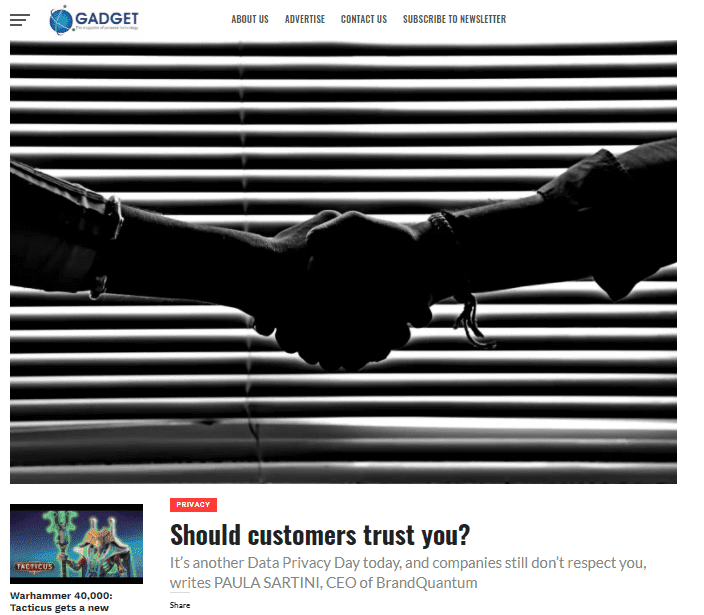Article first published on gadget.co.za on 28 January 2022, written by Paula Sartini
There is no shortage of stories about data breaches and hackers gaining access to personal information across the globe. With customers growing increasingly aware of the dangers of identity theft, companies are prioritising security measures to keep customer and employee data as secure as possible.
However, at the same time, companies are implementing tools to collect user data either via various websites or even from 3rd party solutions to increase customer engagement levels, drive targeted marketing campaigns and improve personalisation.
While consumers are becoming savvier on the data collection front, putting measures in place to protect their personal information and preventing companies from tracking their data without their permission, many of the companies that consumer’s trust are using 3rd party solutions that offer the best value for money but at a cost of customer’s data. This conundrum poses the question of how secure customer data is within a company?
The end of the cookie
Companies such as Apple and Google have committed to prioritising consumer privacy and doing away with cookies, aligning to privacy regulations around the world such as the California Consumer Privacy Act and Protection of Personal Information Act (POPIA). This creates a great challenge for marketers.
For several years marketers have relied on tracking to collect user data via various websites and use this information to engage customers with targeted marketing campaigns and product information. However, the increased regulations and shift in technology companies prioritising customer data and doing away with tracking technology, means that many marketers will need to find new ways to source customer data.
The rise of the data broker
According to HBR, data brokering, which involves collecting and selling data about people is estimated to be a $200 billion business and growing. However, while data brokers most often gathered data by tracking browsing behaviour across different websites, with the end of cookies in sight, these brokers will need to obtain data using alternative sources.
Some ways in which they may gather customer data include loyalty cards, public records, social media posts and even tracking email behaviour using 3rd party solutions that have access to relevant consumer information which is then sold to data brokers. In these instances, the famous quote of 1973 rings true, “If something is free, you’re the product.”
How to secure your customer data
While there are several 3rd party tools available today that value customer privacy and offer built-in-security to help limit possible data hacks and identity theft, some solutions that are used widely track customer data and sell this information to data brokers without the knowledge of the customer.
Although email tracking isn’t new, as is evident in Apple introducing Mail Privacy Protections to prevent senders from using “tracking pixels”, which can identify when someone has opened an email, and introducing a new Hide My Email feature which enables users to respond to emails with random addresses to keep their email address private.
These privacy-centric measures will go a long way in helping to protect customer data, but what does it mean for marketers?
Rethink data collection
As more people become aware of how their data is being gathered and used without their knowledge or consent, companies are going to have to increase security and turn to their own first-party data to engage customers.
According to McKinsey, the right path for each stakeholder will be different, the cornerstone effort should be to create and sustain consumer relationships that produce a value exchange based on trust.
With this in mind, companies need to adopt a zero-party approach to collect customer data, as customers are getting more selective in what information they are giving out and to who. To achieve this, companies need to offer a value exchange to customers, either in the form of promotion, discounts or access to information in exchange for information. They also need to show customers that you value and protect their data by giving them the choice to make their own decisions for example to subscribe to an email newsletter or not. Finally, customers are looking for valuable experiences and want to see the data they have provided, be used to give them the experience they want.
However, trust remains the cornerstone of the customer relationship and to establish customer trust, companies need to demonstrate that they value customer privacy by using secure technologies and having measures in place to protect customer data.
Securing customer data
Establishing customer trust is critical to the success of any business. To maintain this trust there are a few key considerations that companies should be aware of when selecting a 3rd party technology partner to ensure that you are able to keep customer data secure. These include:
- Technologies implemented should have security built upfront
- Technologies should be built with segmentation of risk to safeguard customer content
- Emails should not be rerouted to third parties to tamper with content
- 3rd party solutions should not have access to customer data
- Solutions implemented should be independently tested and align to European standards
- Customer data should be stored securely by the company to prevent possible data breaches
However, while getting the security elements right is critical to building trust, companies cannot compromise on the customer experience in an effort to secure customer data. Getting the customer experience right and keeping customer data secure is a balancing act that marketers need to get right if they are to create meaningful connections and establish a relationship of trust.


